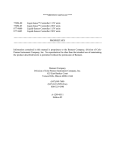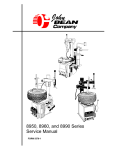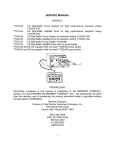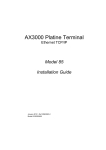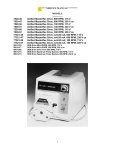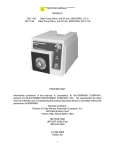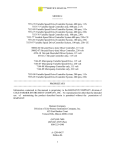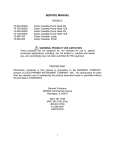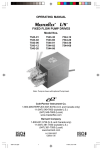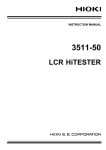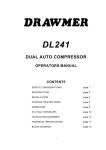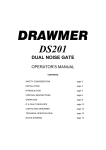Download SERVICE MANUAL
Transcript
********SERVICE MANUAL******** MODELS: 75211-10 Variable Speed Drive, 5000 RPM, 115 V 75211-15 Variable Speed Drive, 5000 RPM, 230 V, CE Mark 75211-60 Variable Speed Drive w/Pump, 9000 RPM, 115 V 75211-62 Variable Speed Drive, 9000 RPM, 115 V 75211-65 Variable Speed Drive w/Pump, 9000 RPM, 230 V, CE Mark 75211-67 Variable Speed Drive, 9000 RPM, 230 V, CE Mark PROPRIETARY Information contained in this manual is proprietary to the BARNANT COMPANY, division of COLE-PARMER INSTRUMENT COMPANY, INC. No reproduction for other than the intended use of maintaining the product described herein is permitted without the permission of BARNANT. Barnant Company Division of Cole-Parmer Instrument Company, Inc. 625 East Bunker Court Vernon Hills, Illinois 60061-1844 (847)549-7600 (847) 247-2929 (Fax) 800-323-4340 A-1299-0983 Edition 01 1 TABLE OF CONTENTS PAGE SAFETY CONSIDERATIONS ......................................................................................... 4 THEORY OF OPERATION ............................................................................................. 5 TROUBLESHOOTING .................................................................................................... 8 REPAIR PROCEDURES................................................................................................. 9 REPLACEMENT PARTS LISTING................................................................................ 11 CALIBRATION PROCEDURE....................................................................................... 12 FUNCTIONAL SPECIFICATIONS................................................................................. 14 2 INTRODUCTION Service for this product is performed at three levels: the customer, distributor/ COLE-PARMER and factory/depot repair. This manual describes distributor/COLE-PARMER service procedures. Customer service procedures are described in the operator’s manual. Customers are encouraged to perform service as described in the operator’s manual as well as in special circumstances where special skills and safety are not considerations. To use this manual, begin with the troubleshooting section to isolate the fault to a replaceable part. The functional description and check out procedure sections are also helpful in determining the faulty part. Distributor/COLE-PARMER repair is limited to replacement of modules as detailed in the replacement parts list section. The repair procedures section detail’s disassembly and assembly procedures. After repair, the product should be calibrated and checked for proper performance. Please refer to the operators' manual (pt. #A-1299-0852) for: A) APPLICATIONS DATA B) PRODUCT DESCRIPTION C) INSTALLATION D) SETUP E) OPERATION F) USER CALIBRATION G) USER TROUBLESHOOTING & MAINTENANCE H) ACCESSORIES I) SPECIFICATIONS 3 SAFETY CONSIDERATIONS Servicing must be performed only by personnel trained and skilled in the methods of troubleshooting and repair of electromechanical products. Use of procedures other than those described in this manual may result in a safety hazard to service personnel and/or customers. WARNING: High voltage is present inside the unit, when servicing any component of this unit be absolutely certain that all power to circuitry is removed. If any functional checks are to be performed while power is applied and chassis is disassembled, care must be exercised. CAUTION: A.) This is a line operated device and is not isolated from ground. Powering the device under test using an isolation transformer is strongly recommended. B.) Do not inadvertently short any part of the printed circuit card to ground, as severe damage will result. 4 THEORY OF OPERATION GENERAL OVER-VIEW A.) The 75211 series controller board employs modular SMT technology (see figure #1) to provide a single board solution, employing an SCR based power amplifier to drive permanent magnet motors. Power Supply A.) AC line is brought in at (J-3 and J-4) and routed through (ON:OFF) switch contacts to power bridge consisting of (CR1,CR2,CR7,CR11). B.) The rectified voltage at (TP #8), is dropped by series resistor (R26 or R35) and regulated to approximately 22.7 VDC at (TP #6) by (VR4). C.) LED connected to J5 indicates power "ON" to circuitry. D.) Varistor RV1 and RC network R1 & C1 suppress line noise generated externally and internally by motor and power bridge. Output Drive A.) Motor power bridge consists of (CR7, CR11, Q1, Q2). Diode (CR13) bypasses the inductive current surges of the motor when the Power Bridge shuts off. B.) Resistor capacitor combination consisting of (R5 and C2) forms a snubber network for commutation noise suppression. Control Section A.) Motor speed is set by front panel pot connected to J6. B.) A +VREF is obtained by regulating the +22VDC supply with (R34 and VR2) to approximately +12VDC. This is routed through network (R33 and R30) to DC ground. Adjustment pot. (R33) sets maximum motor speed approx. +10VDC at (TP-1). C.) Components (R13, CR9, and C6) control acceleration, deceleration of motor RPM. D.) Set-speed is controlled and regulated by differential amp (U1) and related components (R15, C7, R17, and R2, R37, R3). All scaling is done at 5volts full-scale for all op amp circuits. As motor load increases, back EMF, picked off drive output resistor network (R2, R37 and R3), (TP-3) decreases from 5 volts. This is fed through (R17) to pin 2 of (U1-A) causing (TP-2) to charge integrator capacitor (C10) via (R18) to advance the SCR firing angle, until the op amp equalizes its input voltages. E.) Current limit of circuit is accomplished by monitoring the voltage drop of current sense resistor (R4), feeding it through (R19 and R11) to level amp (U1-B) and related 5 components. As current through (R4) approaches [2.0 amps for 120 volt units]; [1.0 amps for 240 volt units] voltage to (TP-4) rises to approximately +5.0VDC. This is fed through resistor network (R22 and R23) at a [2 to 1] ratio, into the peak detector (CR10 & C9). The output of the peak detector is buffered (R21 & Q4) by an emitter follower (Q4 & R25) amplifier which discharges integrator (C10), retarding the SCR firing angle. The resultant firing angle will be proportional to the difference between the torque reference charging current (R18) and the torque feedback discharging current (R25). F.) The SCR will fire when the integrator (C10) voltage is equal to the "PUT" (Q9) reference voltage (VR3: R11; & R12). Line synchronization is achieved by allowing the reference voltage to drop to zero (10-volt window) with each line cross, thereby discharging (C10) through (Q9). (C10 & Q9) form a relaxation oscillator whose period is proportional to the rate of charge of (C10). When the voltage across (C10) is equal to the reference voltage the "PUT" (Q5) is forward biased and will conduct discharging (C-10) through the base-emitter junction of buffer (Q6). (R9) bypasses any leakage current, while (C11) filters out noise pulses. G.) The pulse output of the relaxation oscillator (C10 & Q9) is buffered and amplified by (Q6), and level shifted by a Darlington pair (Q3 & Q8) on 115-volt units, or (Q8 & Q7) on 220-volt units’ fire the Power Bridge SCR (Q1 & Q2). (R7 & R29) limits the gate current, while (CR6 & CR12) blocks back conduction of the Darlington pair. H.) For a detailed view of these signals see figure #2 waveform and related descriptions. Figure 1 Typical controller board employed in the 75211 series drives. 6 Figure 2 1. Waveform #1 Test point #6 2. Waveform #2 Output of scr bridge across motor 3. Waveform #3 PUT charging ramp test point #5 4. Waveform #4 Motor current measured using TEK #TPC-202 current probe 7 TROUBLESHOOTING Repairs on this unit are basically confined to either the units' control PCB and/or the drive motor assembly. Where possible, swap "known good" parts to localize and isolate the problem. The following is a list of possible problems and remedies: UNIT DOES NOT TURN ON; NO POWER LIGHT: 1. 2. 3. 4. fuse blown power cord not connected properly ON-OFF switch failure unit connected to dead outlet -replace fuse -check & replace -replace main PCB -verify supply is HOT UNIT BLOWS FUSES: 1. motor drive failure 2. defective pcb 3. wrong fuse installed -check using known good motor -replace/return to factory -check fuse rating MOTOR WILL NOT RUN: (assumed functional motor) 1. defective ON-OFF switch 2. defective PCB ASSY. -replace switch assy. -replace main PCB ASSY. LOSS OF SPEED CONTROL OR IMPROPER SPEEDS: 1. defective controller PCB ASSY. 2. unit out of calibration -replace main PCB ASSY. -recalibrate PCB ASSY. MOTOR IMMEDIATELY RUNS WHEN POWER IS APPLIED: 1. power output triacs shorted -replace main PCB ASSY. For additional information regarding the unit, please refer to the following: A-1299-0852 operators manual 8 REPAIR PROCEDURES DANGER: When servicing any component of this unit be absolutely certain that all power to circuitry is removed. TO DISASSEMBLE UNIT, PROCEED AS FOLLOWS: A) Remove the four pan head screws on each side of the unit's cover. B) Lift off cover. TO REPLACE PCB ASSEMBLY: A) Slide PC board up and disconnect wire leads B) Position new PCB in circuit board guides. C) Reconnect four wire leads from chassis as follows: 115 volt Models 230 volt Models BLACK from ac line cord to: J#3 BROWN of switch to: J#3 WHITE from ac line cord to: J#4 BLUE of switch to: J#4 WHITE from motor: J#2 WHITE of motor to: J#2 BLACK from motor: J#1 BLACK of motor to: J#1 D) Check calibration per applicable calibration specification. TO REPLACE SPEED POTENTIOMETER: A) B) C) D) Remove knob and mounting hardware. Slide pot. assembly out of the control panel. Install new pot. assembly in reverse sequence. Verify that when the knob is turned fully counter-clockwise, the indicator line is directly above S in “Speed” on control panel. 9 TO REPLACE ON-OFF SWITCH: A) Remove switch. B) Slide switch assemblies out of control panel, noting which side the terminals are facing. C) Insert switch assembly into control panel with terminals in proper direction. TO REASSEMBLE UNIT, PROCEED AS FOLLOWS: A) Carefully plug all connectors into PCB observing proper orientation of plugs. B) Reinstall the eight pan head screws on the cover of the unit. 10 REPLACEMENT PARTS LIST The following is a list of stockable main control PCB assemblies, and their reference schematic diagrams for all indicated models: ---115volt---MODELSMODEL# PCB# REFERENCE SCHEMATIC 75211-10 D-2204-0004CR E-2193 75211-60 D-2204-0006CR E-2193 75211-62 D-2204-0006CR E-2193 ---230volt---MODELSMODEL# PCB# REFERENCE SCHEMATIC 75211-15 D-2204-0005CR E-2193 75211-65 D-2204-0007CR E-2193 75211-67 D-2204-0007CR E-2193 The following is a list of commonly used parts applicable to the above model LISTINGS: DESCRIPTION BARNANT Part# Speed adjustment knob B-1083-0062 Motor (115VAC) D-2799 Motor (230VAC) E-2128 Rubber foot A-1390-0004 ON-OFF switch B-1084-0104 Speed pot. assembly 5903 Hub assy. B-3478 11 CALIBRATION After repairs are made, the unit must be tested to assure proper performance to specifications. In many cases, servicing personnel to accomplish this can use factory/QC checkout procedures. For calibration procedures please refer to the following (CAL-SPECIFICATION) listings table appropriate to the model that is being serviced. MODEL# CAL-SPECIFICATION # 75211-10 CAL.-1857 75211-15 CAL.-1857 75211-60 CAL-1858 75211-62 CAL-1858 75211-65 CAL-1858 75211-67 CAL-1858 Additional technical specifications are available in the unit's OPERATOR MANUAL. Because this manual is covering approximately 6 different models, exact calibration procedures will differ between each unit. However, the following procedure may be used to roughly calibrate an out-of-spec. unit. 12 BEFORE PROCEEDING FURTHER PLEASE NOTE ALL WARNINGS AS LISTED IN THE "SAFETY CONSIDERATIONS SECTION"!!! TOOLS REQUIRED A) #1 Phillips screwdriver B) Non-metallic pot-tweaker C) Hand-held tachometer PROCEED AS FOLLOWS: 1) Remove the four pan head screws on each side of the unit's cover and lift off. 2) Pots are adjusted from the topside using an insulated pot tweaker. 3) Plug unit into the appropriate line voltage. If this can be done through an adjustable variac, to e.g. 115 vac (115 volt units) or 230 vac (230 volt units). 4) Turn unit on, set speed control for maximum. 5) Measure & turn pot R-28 (multi-turn) to obtain proper motor terminal voltage as follows: 50.0 vdc +/- .5 vdc (for 75211-10) 90.0 vdc +/- .5 vdc (for 75211-60 & 75211-62) 180.0 vdc +/- 1.0 vdc (for 75211-65 & 75211-67) 100.0 vdc +/- .5 vdc (for 75211-15) NOTE: The motor should be rotating CW when viewed from the output shaft of the motor. If not, reverse wires at J1 and J2 on PC Board. 6) Pot R-31 is used to set the units no-load to full-load response and therefore should not be field adjusted. 7) Seal pot adjustments and reassemble unit. 13 SPECIFICATIONS LINE VOLTAGES: MODEL# NOM MIN MAXIMUM 75211-10 115 volts 90 volts 130 volts 75211-60 115 volts 90 volts 130 volts 75211-62 115 volts 90 volts 130 volts 75211-15 230 volts 190 volts 260 volts 75211-65 230 volts 190 volts 260 volts 75211-67 230 volts 190 volts 260 volts LINE FREQUENCY: All models SINGLE PHASE 50/60 hertz TEMPERATURE & HUMIDITY: MINIMUM MAXIMUM 0˚C 40˚C STORAGE TEMPERATURE: -25˚C 65˚C HUMIDITY (NON-COND.): 10% 90% OPERATING TEMPERATURE: 14














